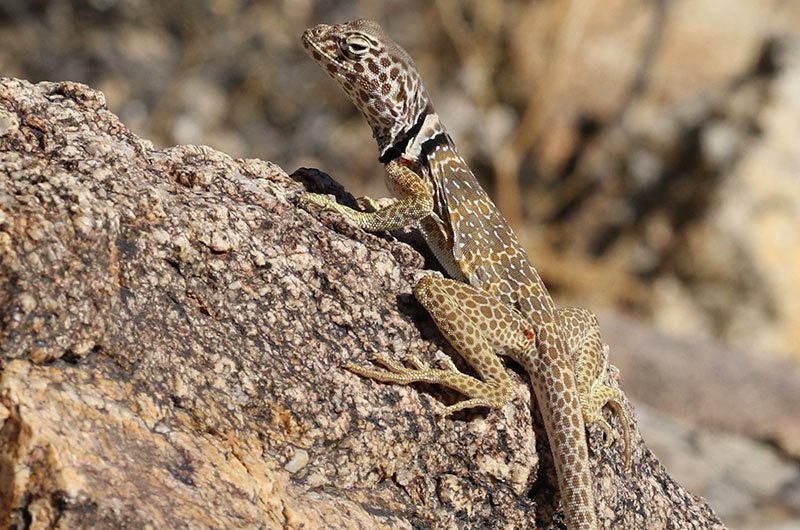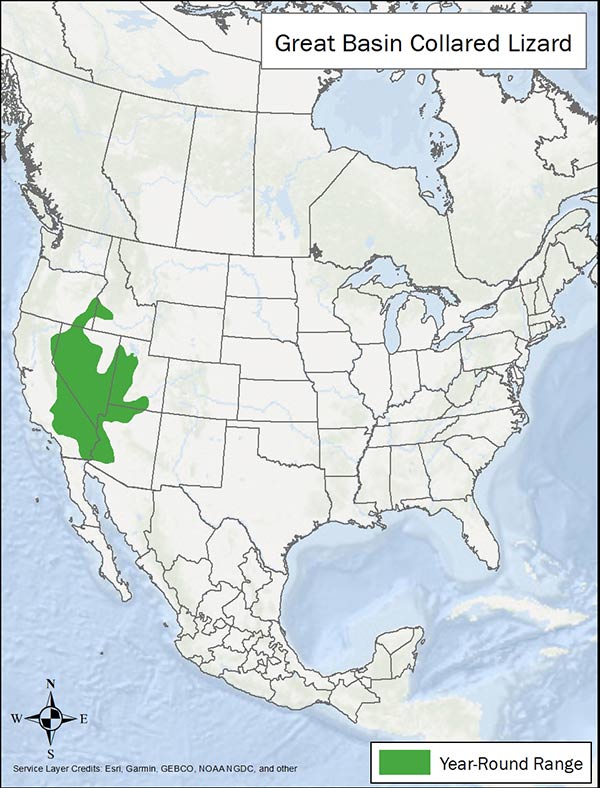LandPKS Learning
Habitat Hub

Great Basin Collared Lizard
Collared lizards are one of the only lizards that can run using only their hind legs. They are fast with strides up to three times their body length.
Crotaphytus bicinctores
Identification
The Great Basin collard lizard, also called Mojave black-collared lizard is 2.5-4.5 in/6-11 cm long with a large, broad, white head with brown spots and a long tail. They have two distinct black collars separated by a white band around their necks and mostly white undersides. Their backs are light tan to gray or reddish brown with fuzzy lighter crossbands. Adult males are green, tan, or olive with many white spots, while females are less colorful. Their legs have yellow spots, and the back legs are relatively large.
Observation Tips
The Great Basin collared lizard is found in arid and semiarid regions of the Mojave, Sonoran, and southeastern Great Basin within the United States. During the winter season, the collared lizard is inactive. During the active months, these lizards spend most of their time in rocky areas seeking shade and protection from predators. They are active during the daytime and very heat tolerant. They are likely to be seen basking on top of small rocks.
Interesting Fact
Collared lizards are one of the only lizards that can run using only their hind legs. They are fast with strides up to three times their body length.
Ideal Habitat
Collared lizards live in dry, rocky areas with sparse vegetation, juniper forests, and sagebrush shrublands habitats. They are found in rocky, hilly areas within the Great Basin. Great Basin collared lizards are generally restricted to areas with rocky slopes, gullies, canyons, and rock piles (>20% rock fragment). They hide under rocks and in rodent burrows. These lizards eat small vertebrates and invertebrates.

Range map provided by International Union for Conservation of Nature
Management Activities that Benefit Species – Best Management Practices (BMPs)
Maintain rocky areas within sagebrush shrublands and deserts in Great Basin collared lizard habitat. Well-managed livestock grazing is compatible with lizard habitat needs as they do not require specific vegetation cover. In order to provide appropriate habitat for their prey, invasive species should be managed using an integrated approach.
Management Activities to Avoid
Avoid collecting or allowing collection of Great Basin collared lizards. If you see a Great Basin collared lizard, avoid picking it up. Avoid extensive off-road vehicle use in collared lizard habitat as they spend time sunning on rocks in the open.
Other Species that Benefit from Similar Habitat Management
Other lizard species and desert species, including their predators, loggerheaded shrike, hawks, and coachwhip snakes, will benefit from habitat management for Great Basin collared lizards.
Download
Download the Great Basin Collared Lizard factsheet
Other Resources
California Department of Fish and Wildlife. Life history account Great Basin Collared Lizard
International Union for Conservation of Nature (IUCN). 2014. The IUCN Red List of Threatened Species. Version 2021-1 Great Basin Collared Lizard
NatureServe, 2019. NatureServe Explorer: An online encyclopedia of life [web application]. Version 7.1. NatureServe, Arlington, Virginia. Great Basin Collared Lizard
Photo credit: Tom Benson/Flickr
Mobile App | Data Portal | Knowledge Hub | Habitat Hub | Learning Collections | Blog | About | Contact | Support



